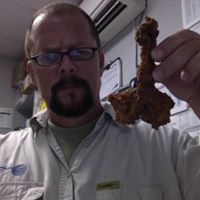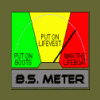Leaderboard
Popular Content
Showing content with the highest reputation on 02/25/2010 in all areas
-
2 points
-
At $10k per dose, not all hospitals will be on board for that. Also, the patient will have to meet the criteria for it as well. http://www.xigris.com/Pages/organ-dysfunction-assessment-animation.aspx THAM is a buffering agent that does not break down to CO2 which is ideal for permissive hypercapnia. However, it will require close glucose monitoring. Good reading: http://ajrccm.atsjournals.org/cgi/content/full/162/4/1361 http://ajrccm.atsjournals.org/cgi/content/full/161/4/1149 A lactate level may diagnose sepsis and a CXR may either indicate a PNA with or without a pattern for ARDS. Fluids and pressors may be initiated but the ED doctor will be wanting this patient out of his/her ED quickly and into an ICU bed where ScvO2 monitoring, an A-line and the ICU ventilators are. Eydawn Acute Respiratory Distress Syndrome (ARDS) is a syndrome of inflammation and increased permeability associated with a constellation of clinical, radiologic, and physiologic abnormalities unexplained by elevations in left atrial or pulmonary capillary pressure. Criteria: Identifiable associated condition Acute onset Pulmonary artery wedge pressure </=18 mm Hg or absence of clinical evidence of left atrial hypertension Bilateral infiltrates on chest radiography Acute respiratory distress syndrome (ARDS) is present if Pao2/Fio2 ratio </= 200 Acute lung injury (ALI) is present if Pao2/Fio2 ratio is </= 300 We will also do a BAL (bronchoalveolar lavage) to gather fluid for multiple diagnostic tests. For H1N1 Flu Associated ARDS, patients seemed to experience a cytokine storm. Very, very nasty ARDS to deal with which is why the deaths but unknown why the young were so harshly affected. Clinical conditions associated with ARDS Direct lung injury Pneumonia Aspiration of gastric contents Inhalation injury Near drowning Pulmonary contusion Fat embolism Reperfusion pulmonary edema post lung transplantation or pulmonary embolectomy Indirect lung injury Sepsis Severe trauma Acute pancreatitis Cardiopulmonary bypass Massive transfusions Drug overdose Good ARDS ppt. http://www.ohsu.edu/radiology/med/chest/ards.ppt Thus, you can have PNA with localized infiltrates and go home with a script. If you have require a ventilator and an RRT at your bedside 24/7 for severe hypoxia and diffuse infiltrates, you probably have ARDS that may have been precipitated by that PNA infection either bacterial or viral. ARDS also goes down the path of multisystem organ failure and is not just isolated to the lungs. This is the reason I pointed out the caution with being overly aggressive with the ventilator until BP MAP is tanked up with pressors and fluids. Something will shut down and it the additional ventilator settings hurried that along, it may be difficult to recover or resuscitate the patient. Acute Respiratory Failure can be from many causes including the patient too tired to work at breathing to compensate for lungs or better term "cardiopulmonary" system that is failing them. People with pending ARF may have normal blood gases or close to it right up to the point of the tube. One thing I hate to hear is "but the ABG is normal" when the patient is huffing at 40 breaths per minute and diaphoretic with a BP that is about to bottom out. For this patient breathing at a rate of 40, the term should be tachypnea rather than "hyperventilation" unless the ABG confirms a low PaCO2 which could be possible with sepsis (falling pH) or a PE. By definition, respiratory failure is defined as a PaO2 value of less than 60 mm Hg while breathing air or a PaCO2 of more than 50 mm Hg. ARDS patients will do well to have a 60 mmHg on 100% oxygen. The act of respiration engages 3 processes: (1) transfer of oxygen across the alveolus, (2) transport of oxygen to the tissues, and (3) removal of carbon dioxide from blood into the alveolus and then into the environment. Respiratory failure may occur from malfunctioning of any of these processes.1 point
-
Not even close to how they'd answer the phone, how the medic would reply, and how he would start off his report, or how he would give his report, including speed. Also, don't hear any sirens in the background (guess they could have still been parked on-scene...but with the commotion going on outside the ambulance, I'd think they'd want to get out of there). And while LA does give super detailed reports (supposedly because they don't trust the medics, with good reason for most) to the point that it'd detrimental to the patient because you're waiting on-scene, if the report was actually 3-minutes, it would be rapid fire talking from both ends. Maybe this was a report given by someone else on-scene to a specific doctor rather than the official call-in, though doubt that too. There's no background noise whatsoever...whether in ambulance or outside, based on the video, there should be a lot of it. The phrases used...just wouldn't be used in a base report. AND there's one easy way to confirm. Just pull the tapes of the actual call-in...which I imagine would have already been done...1 point
-
That is just stupid... Any of you, perhaps I'm just less accomplished here, have a spare 3 minutes to give a radio report while working an arrest? Have you EVER had anyone on the other end of the call that would be interested in listening to a 3 minute report? Yeah, me either... "MedicX enroute to your facility emergent with a high profile pt, pulseless and apneic, unknown down time, CPR in progress, 3 rounds ACLS completed without change in pt status, will update upon arrival. Questions?" I'm not sure how anyone can take that recording seriously, but some fuckhead just got himself a book deal and tour of the talk show circuit . Makes me want to spit... Dwayne1 point
-
Lots of fire departments WANT to do EMS because they WANT the run numbers, they WANT the ability to say that they're revenue-generating, and they WANT to justify half-million to million-dollar vehicles whose primary purpose is not, in fact, EMS. Doesn't for one second mean they're going to do it RIGHT. There's a difference between desire and motivation.1 point
-
The trouble is not worth the expense. Besides, if your only lighting is on the front, then nobody else around you is aware of why you're driving as you are. Making for another dangerous situation. A single beacon, visible 360°, is all you should need, if it's just that. Needed. I, personally have no issue with vehicle lighting, provided you're only using it to be seen, while sitting on or along a highway. A Kojak light should be fine for that. If you need it for response, then it should be bolted to the vehicle. If it's magnetic, then it's not meant to be used while not stationary. I know they can be, and they are used that way, but DOT and Mfg. guidelines do state, they should not be used on moving vehicles; regardless of whether or not that is followed.1 point
-
1 point
-
POV lights should always be mounted on the wall in the basement for those hoppin' dance parties!! Do you also have a siren? Are you under emergency services insurance? Are you 100% sure if you get in a wreck while L&S, you will be covered by insurance if you kill someone who does not yield do your POV? Are you sure you can live with yourself if you do injure someone on the way to a brush/garbage fire? Just some questions to ask yourself. You may be able to tell, I am not a fan of POV lights. If you are required to respond "Hot" to the hall, they should supply you with an emergency vehicle with the proper reflective decaling, safety standards, and provide defensive driver training.1 point
-
Again, I opine that Fire Departments that wanted to do EMS duties seem to do better than Fire Departments that are told from outside their agency, that they HAVE to take on EMS duties. No apparent "sibling rivalry", either in a paid or volunteer department, in that regard. That is my observation, from talking with members of such departments, and articles I've read in JEMS and EMS Magazine.1 point
-
Survival of the fittest. This is why I don't recommend the privates as a place to make a career in EMS. The local gov't ultimately reserves the right to run EMS as they see fit. I hate to see people lose their jobs, but it's an "us or them" mentality. If it's a choice of my job or the next guy's, I choose to keep mine. I'm not going to let my family starve if I have a way to prevent that. The IAFF uses yellow shirts to provide high visibility by choice. Because it works. Look at the video. Who jumps out at you, and appear to be in greater number?1 point
-
Is it possible to intubate a baby? Granted, I'm not well versed in ETT's, but what I was told is that you can't insert an ETT into a patient less than 4 feet tall. Since the patient is referred to as 'a baby', I can only surmise that this patient was less than the requisite 4 feet in height.1 point
-
Hello all, I have a 2006 Dodge Ram 1500 pickup truck. I recently bought these lights (http://www.ledoutfitters.com/index.php?target=products&product_id=16 ) for my truck grill as I am an EMT/firefighter in New York State. Can anyone help me with mounting them? Also I noticed that they are a little big for the opening between slats in my grill, can anyone help with that? Thanks.-1 points
-
And were might I ask is the statistical data to prove that EMS services are diminished by fire department participation?-2 points








